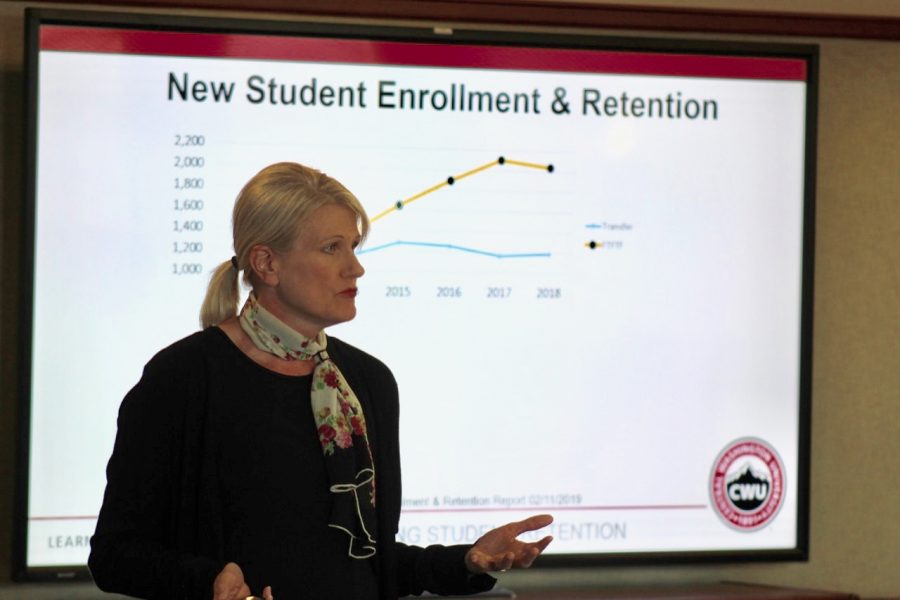New programs seek to fight dropping retention
The problem of retention was brought to attention at the April faculty senate meeting. While new student numbers are rising, those students are not staying at CWU for as long as they previously were.
April 24, 2019
A university’s retention rate is the percentage of students who stay after their first year of attendance, and CWU’s retention rate is dropping. In 2013 78.9 percent of students kept attending CWU after their first year, and in 2017 that number had dropped by 9.6 percent to 69.3 percent of students staying.
The reasons that students leave may be many, but looking at another statistic may show one of the biggest underlying reasons for this drop.
In the four years between 2013 and 2017, CWU has grown by over 30 percent. First-time/ full-time freshmen enrollment grew by 686 students from 1,416 to 2,102 students. This is an increase of 48.4 percent. According to Dean of Student Success Gregg Heinselman, the lowering retention rate may be due to growing pains.
“Growth always tests and challenges systems. It tests and challenges advising, class size [student/teacher ratio], for instance. That typically is a cycle that an institution will see, you grow, you measure the success of that growth, and you adjust your program to meet needs,” Heinselman said.
Although retention rates are just one small part of measuring a university’s success, it is one that many CWU officials are making a concentrated effort on improving. One measure taken towards this has been the change in the general education requirements’ structure. Largely driven by efforts from the general education department, the first year and exploratory advising department and provosts such as Associate Provost of Undergraduate and Faculty Affairs Dr. Gail Mackin.
“The faculty were very intentional about creating a program that would engage and excite students about a broader liberal arts curriculum,” Mackin said. “But also understand that the skills and preparation that is intentionally inserted into the general education program is connected, it’s thematic.It serves a purpose in enabling students to grow academically and personally as a Washington, national, and global citizen.”
Both Mackin and Heinselman believe the new general education (GED) program will be a lot more flexible and will give more of an opportunity for students to explore new subjects rather than following a straightforward path. The ability to find a new course if another isn’t the best is something that Heinselman stressed as important.
“If you’re coming from that traditional high school and then next fall you’re right into being a college student, you may be coming from a high school that didn’t offer that variety of disciplines that we offer here at [CWU],” Heinselman said. “Or you may be that college student that thinks they know what they want to study but you haven’t quite decided because you haven’t taken classes in that subject matter. The new system, I think, opens it up and allows you to explore more.”
In addition to revising the GED program, CWU will be introducing a first-year seminar program. These are small lecture courses to help students practice analytical skills and connect them to the faculty of different subjects. 51 sections are currently scheduled for the upcoming fall quarter.
While the majority of students who attend CWU started as freshman coming from high school, not all students began college here. Almost 1,500 students at CWU transferred from another higher-learning institution, and with their situation comes a variety of differences in their needs. Some students have taken classes equivalent to those offered as GEDs and don’t need to waste their own time and money re-taking those classes. Some haven’t gotten the chance to explore CWU’s program options, and some just need help adjusting to the new environment. In an attempt meet these challenges, CWU is developing a transition center.
“Primarily, the goal is to assist students who are thinking about transferring to CWU to understand those requirements before they get here so they’re taking the right courses, talking to the right professors, have the right advisors,” Mackin said. “And then to assist those students when they get here in that first year before they’ve really assimilated.”
More programs are being worked on in order to help bring retention rates back up while still allowing CWU to grow, as the university’s capital master plan projects that between now and 2021 CWU will grow in enrollment from 11,400 to over 14,000 students.
According to Mackin, discussions on how to restructure the advising model are currently taking place, and officials and faculty are working on new ways of communicating with the former schools students attended to make sure that they have all of their requirements and can go forward confidently into their time at CWU.



